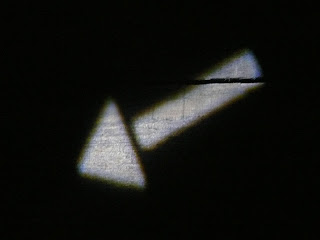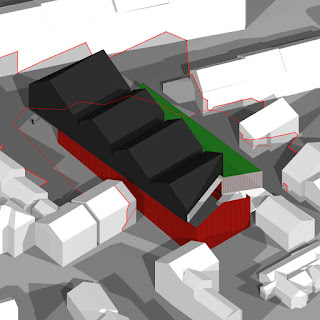I
choose option where 2
Demarco programmes
are physically separated because of distinct functions these
programmes serve - one is about creating and another is about storing.
I decided to place these programs in different environments and
Roseangle area is good in providing diverse urban
characters.
Consequently, I put gallery and residences in more residential
area whereas archive sits within more urban environment on Perth Road
which joins with many cultural institutions of Dundee.
In spite of their physical separation, I see both programs as a whole body where lanes work as arteries which joins inseparable parts of the body. I see this as Art complex within unique district.
My approach was to effectively use existing grid of streets and volumes and presume the district as a solid mass from which to carve spaces of. The main idea therefore is to create a dialogue between old existing and new one.
This somehow relates to my understanding about Demarco's contribution in process of breaking walls and making links between worlds - creating a dialogue within tight limitations.
Both programmes together are a whole body where lanes work as arteries which joins inseparable parts of the body. Art complex within unique district.
Open public spaces as connective tissues within a body.
Open spaces enrich this complex and a whole district as well as invole the local community.
_________________________________________________________________
Demarco gallery and residence
In case of Demarco gallery and residence I was using existing buildings with uncovered gables as matrices for new extensions.
Carving voids and spaces
Spatial relationship between programmes and functions - physical and visual connections. Demarco archive - gallery - studious-Demarco residence - artists’ flats.
Creating spatial relationship between residence and gallery.
Accenting entrance and setting volumes parallel.
Creating paths
Articulation of open public and private spaces. Making enclosure and continuing the street.
Serial vision sketch shows approaching and passing gallery and urban realm created by narrow lanes and liberating extensions of the space.
If wall is public then windows are expression of privacy and vice versa.
Windows as expression of content and personality.
Conventional and contemporary forms of windows.
As a case study I chose Pier Arts Centre in Stromness, Orkney by REIACH AND HALL ARCHITECTS.
Photo: http://www.reiachandhall.co.uk/project/arts_cultural/pier_01.htm
Seamless volumes - new and old linked together with translucent threshold.

"The charming harbour town of Norwegian origin called
Stromness is the result of two dominant building types
huddled together into a weather worn hand. The ends of
long chimneyless pitched roof sheds made of different
materials upon dry stone bases like stubby fingers in
the water and, by road, two storey houses placed
either parallel or perpendicular, their chimneys flush to
windowless gable ends.
This is an insistent and dogged morphology, a huddled
together architecture that reminds me both of the
position espoused in the built work and writings of
Aldo Rossi and the responsively loose and nuanced
buildings of the Portuguese architect Alvaro Siza whose
work transformed these typologies into more expressive
and freely open compositions. One might characterise
the exterior expression of the project by Edinburgh
practice Reiach and Hall - to extend the Pier Arts Centre
with a refurbished building on the street and a new one
facing the sea - as located somewhere between these
two canons and, as such, offering a powerful regional
exemplar."

"I wouldn’t like to refer to my halls as architecture at all. I’d
rather talk about structures. To me, architecture sounds
too demanding and, on the other hand, it always makes
me think of too much contrasting, artificial, unnecessary
form. A structure is historically and locally oriented, built
with the simplest, reliable materials and constructions
that local craftsmen can master. A structure is so to
speak, cleansed with architecture, I find that pleasant,
in principle, for artistic room though it is the only attitude
that I can accept."
Quotes from:
http://www.reiachandhall.co.uk/project/arts_cultural/pier_01.htm
Initial structural scheme for lower volume. Massive loadbearing masonry walls supports upper structure and do bracing.
Upper volume's structure - lightweight frame using 2x18mm structural plywood. Ribs in both directions (vertical and horizontal) are 300mm deep.
_________________________________________________________________
Demarco archive
Existing building (not listed by Historic Scotland) is significant witness of industrial past and
interesting by its typology and sitting in the
surrounding landscape and urban fabric.
Adding intervention within the plot boundaries and keeping existing brick shell. Cornice aligned with surrounding four-storey tenements across the Perth Road.
New volume is pushed towards the street creating covered open space and pulled from another side to provide light for galleries deep inside.
Stretching front side of the volume up to allow
extra floors accommodate and stretching back side to form inner courtyard for getting more light in one corner.
Braking scale by splitting up into four volumes each with double pitched roof which corresponds to surrounding roofscape and scale. Ridge is aligned with surrounding four-storey tenements across the Perth Road.
Shadow analysis shows existing and designed situations with overshadowing adjacent buildings.
Time of analysis 21st March/September,
9:00AM, 12PM, 3PM.
See more at STUDY WORKS



























































